Python, renowned for its simplicity and efficiency, equips programmers with powerful tools to handle repetitive tasks seamlessly. At the core of this capability lies the concept of loops, pivotal in automating tasks and iterating through data structures.
This article serves as a comprehensive guide to Python loops, shedding light on their functionality, variations, best practices, and real-world applications. Delving into the intricacies of for and while loops, loop control statements, and their strategic use, this exploration aims to empower learners and practitioners alike in harnessing the full potential of iterative control structures.
Join us on this journey as we unravel the intricacies of Python loops, showcasing their versatility and practicality in simplifying complex tasks and streamlining coding endeavors.
What is the purpose of loops and repetitive tasks in programming?
In the world of programming, loops serve as iterative tools, allowing the execution of specific code segments repetitively based on predefined conditions or sequences. Their primary function lies in automating repetitive tasks, aiding in enhancing efficiency and reducing redundancy within programs.
Loops, as iterative control structures, enable the repetition of a designated block of code until certain conditions are met or for a predetermined number of iterations. They facilitate the iterative traversal of collections, such as lists, tuples, or dictionaries, or execute a set of statements based on a specified condition.
Their significance in programming is evident in their ability to streamline repetitive operations, effectively eliminating the need for manual replication of code. By employing loops, programs become more concise and easier to manage, contributing to improved code maintainability.
Moreover, loops offer flexibility in handling dynamic data. They accommodate varying data lengths, allowing for the dynamic processing of collections without requiring the explicit definition of individual elements.
In essence, loops stand as fundamental constructs in programming, essential for efficiently managing repetitive tasks, promoting automation, and facilitating streamlined workflows within Python programs.
What are the different types of Python loops?
Embark on a journey through Python’s looping mechanisms, pivotal tools for iteration and control within programs. Explore the for loop’s prowess in traversing sequences and the versatile while loop’s dynamic execution based on conditions. Let’s unravel these looping paradigms and their practical code applications.
Diving into for Loops:
The for loop in Python is a workhorse for iterating through sequences, performing a specified action for each item in the sequence.
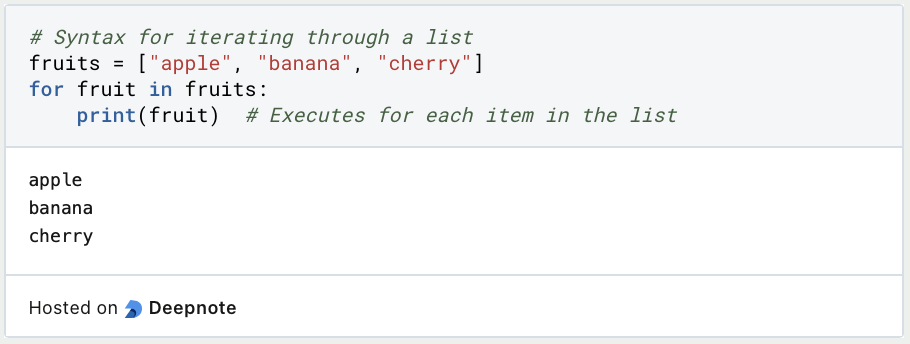
It elegantly traverses sequences like lists, tuples, or dictionaries, processing each element individually. Moreover, the range() function elevates for loops by generating numerical sequences for controlled iterations.
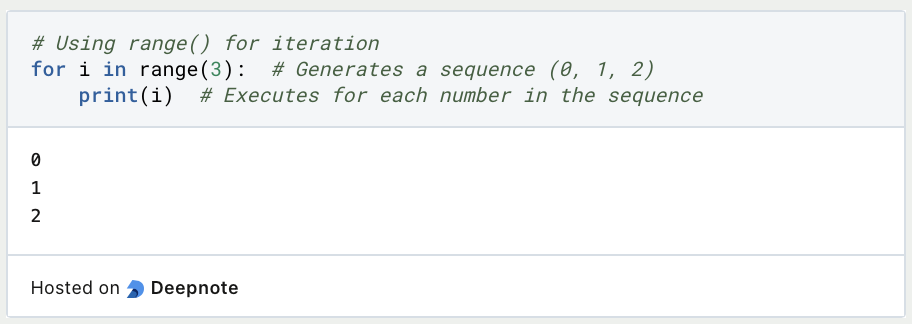
Embracing the while Loop:
Conversely, the while loop powers iterative processes based on conditions, continuing execution until the condition becomes False.
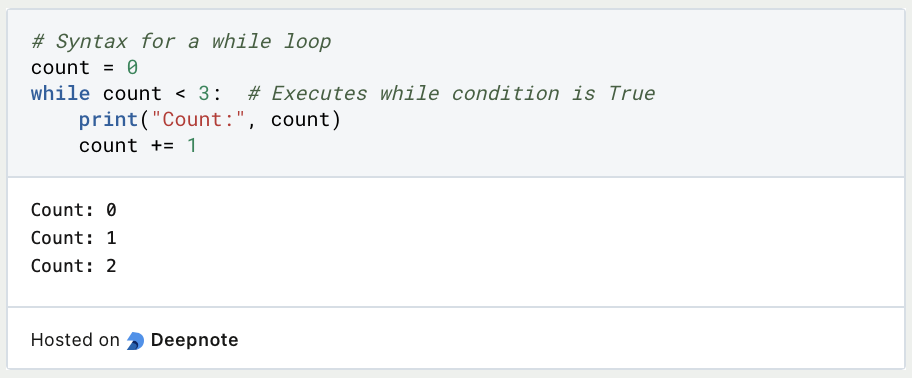
It operates on a condition, allowing flexibility in controlling iteration based on evolving scenarios or dynamic criteria.
Understanding these looping mechanisms enhances programming versatility, enabling efficient handling of iterations based on sequences or conditions within Python.
What are the differences between the while loop and the for loop?
The Python programming language provides several loop structures to facilitate repetitive execution of code. One of the fundamental loop structures is the while loop. Let’s explore how the while loop compares to other loop structures, such as the for loop and the do-while loop:
- Python
whileLoop: Thewhileloop allows you to repeatedly execute a block of code as long as a specified condition is true. It provides a flexible approach when the number of iterations is not known beforehand. The condition is checked before each iteration, and if it evaluates to true, the loop continues. Otherwise, the loop is exited. This loop structure is useful when the termination condition depends on dynamic factors or user input. - Python
forLoop: Theforloop is another commonly used loop structure in Python. It is designed for iterating over a sequence (such as a list, tuple, or string) or any object that is iterable. Unlike thewhileloop, theforloop iterates through a predefined set of values, and the number of iterations is known in advance. Each item in the sequence is processed one by one until the loop completes. This loop structure is suitable when you have a fixed set of elements to iterate over. - Python
do-whileLoop: Unlike some other programming languages, Python doesn’t have a built-indo-whileloop structure. However, you can simulate its behavior using awhileloop with an additional condition check. In ado-whileloop, the code block is executed at least once, and then the condition is checked for further iterations. If the condition is true, the loop continues; otherwise, it is exited. This structure is useful when you want to ensure that a block of code is executed at least once, regardless of the condition.
While each Python loop structure has its own purpose and benefits, it’s important to choose the one that best suits the specific requirements of your code. Consider the following factors when deciding which loop structure to use:
- The nature of the problem you are solving: Determine if the loop requires a fixed number of iterations or depends on a dynamic condition.
- The type of data or sequence you are working with: Choose the loop structure that aligns with the data structure you need to iterate over.
- The need for an initial execution: Consider whether the loop should execute at least once before checking the termination condition.
By understanding the characteristics and differences between the while loop and other loop structures like the for loop and the simulated do-while loop, you can make informed decisions on which loop structure to employ in your Python programs.
What are control statements of Python Loops?
Within Python loops, specialized control statements offer precise control over iterations. Explore the break, continue, and pass statements—each serving distinct purposes in manipulating Python loops. Let’s unravel their functionalities and explore how they empower efficient iteration management.
The break Statement:
The break statement serves as a mechanism to swiftly exit a loop before its natural conclusion, helping prevent unnecessary iterations.
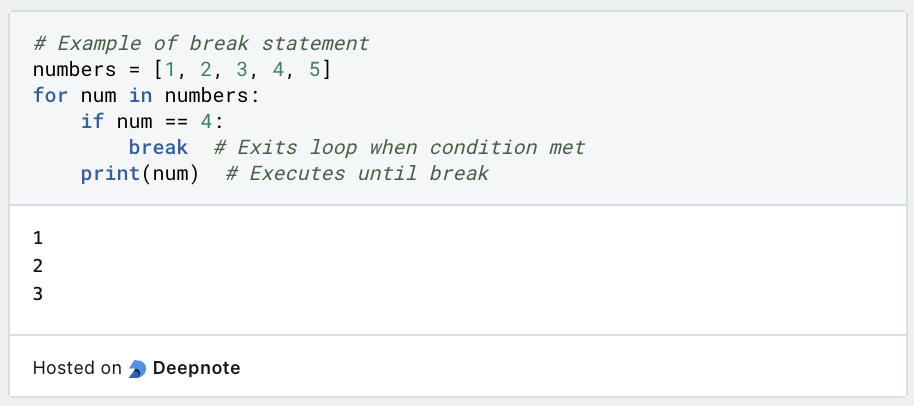
Use Cases:
- Early Termination: Ideal when a specific condition is met, enabling an immediate exit from the loop.
- Search Operations: Efficient for search tasks where the objective is found, halting further iteration.
The continue Statement:
Contrarily, the continue statement allows skipping specific iterations within a Python loop, resuming with the next iteration.
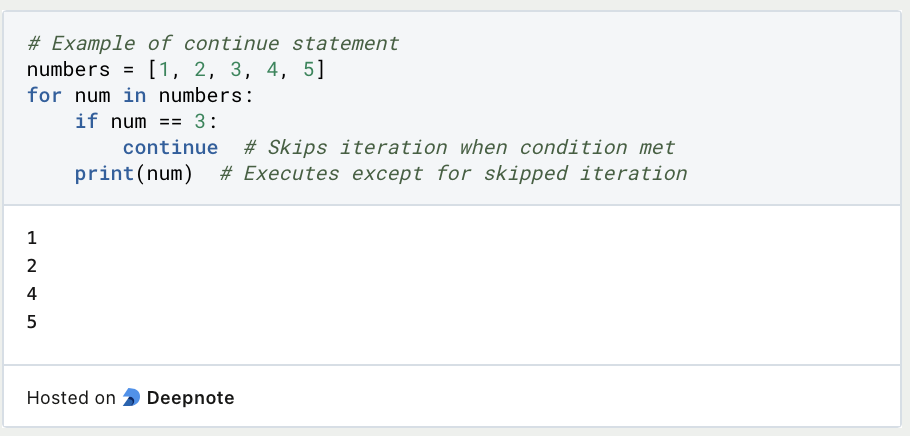
Use Cases:
- Skipping Iterations: Useful when certain iterations need to be bypassed based on specific conditions.
- Processing Exceptions: Assists in excluding certain elements from processing within the loop.
The pass Statement:
The pass statement acts as a placeholder, preserving syntactical structure without executing any specific action.

Use Cases:
- Structural Placeholder: Helpful in scenarios where no specific action is required but a placeholder is necessary for code completeness.
- Stubbing Functions/Classes: Acts as a placeholder in creating functions or classes yet to be implemented.
These control statements enrich the flexibility and precision of loops in Python, allowing programmers to tailor iterations precisely according to the problem’s requirements.
What are Nested Python Loops?
Delve into the intricate world of nested loops within Python—a fundamental concept offering the ability to execute loops within loops. Discover how this nesting capability provides the means to navigate complex data structures and patterns with finesse and precision. Join this exploration to comprehend the significance and versatility of nested loops in Python programming.
Unveiling Nested Loops:
Nested loops in Python embody the concept of loops within loops, allowing the execution of one loop inside another.
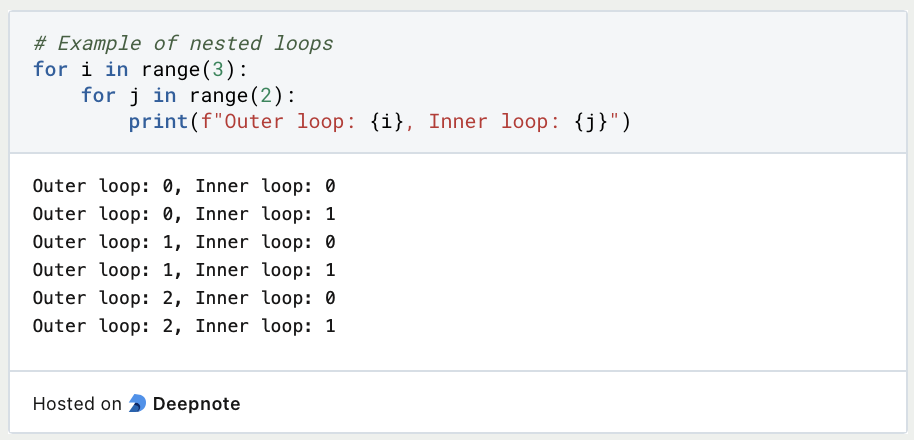
Relevance in Handling Complexity:
Nested loops are instrumental when working with intricate data structures or patterns, enabling comprehensive iteration through multidimensional data.
Handling Complex Data Structures:
- Matrix Operations: Essential for traversing rows and columns in matrices or multidimensional arrays.
- Nested Lists and Dictionaries: Facilitates exploration of nested data structures within lists or dictionaries.
Pattern Generation:
- Geometric Patterns: Useful for generating complex geometric patterns through dual-level iteration.
- Search Space Exploration: Valuable in exploring nested search spaces for exhaustive search algorithms.
Nested loops stand as indispensable tools in Python programming, empowering developers to navigate and manipulate multidimensional data structures and intricate patterns with precision and control.
What are Best Practices and Tips when working with Python Loops?
Effective utilization of Python loops not only demands precision but also adherence to best practices. Explore these essential tips and strategies—crafted to elevate your loop-based coding—to ensure efficiency, readability, and optimized performance in your Python programs. Dive into these valuable insights, honing your loop-writing skills for seamless and robust code execution.
1. Use Descriptive Variable Names: Employ clear and meaningful names for loop variables to enhance code readability and comprehension.
2. Avoid Infinite Loops: Ensure Python loop termination by validating conditions to prevent unintended infinite looping.
3. Prefer enumerate() for Index Tracking: Utilize enumerate() for indexing when iterating through sequences to track indices efficiently.
4. Initialize Outside the Loop: Initialize variables outside the loop to prevent reinitialization within each iteration, optimizing performance.
5. Leverage List Comprehensions: Employ list comprehensions for concise and efficient iteration over sequences, enhancing code elegance.
6. Consider Generator Expressions: Use generator expressions when dealing with large datasets for memory-efficient iteration.
7. Profile and Optimize Loops: Profile loop performance using tools like timeit to identify bottlenecks and optimize code for speed.
8. Break Down Complex Loops: Refactor complex nested loops into smaller, more manageable functions to enhance code maintainability.
9. Know When to Use Loops: Evaluate alternative methods like vectorized operations or built-in functions for specific tasks where Python loops might not be the most efficient solution.
10. Document Loop Logic: Provide comments or documentation to explain intricate loop logic or uncommon iterations for improved code understanding.
Adhering to these best practices ensures efficient, readable, and optimized loop-based code, enhancing the effectiveness of Python programs.
This is what you should take with you
- Python loops, including
forandwhile, are versatile tools for iteration, vital in automating tasks and controlling program flow. forloops excel in traversing sequences, whilewhileloops offer dynamic iteration based on conditions.- Python loop control statements (
break,continue,pass) enrich loop functionalities, providing precise control and structural placeholders. - Nested loops navigate complex data structures and intricate patterns, enabling multidimensional data exploration.
- Best practices such as using descriptive names, avoiding infinite loops, and optimizing loop structures enhance code readability and efficiency.
- Understanding when to use each Python loop type and employing the right looping strategies is fundamental for proficient Python programming.
Python Programming Basics: Learn it from scratch!
Master Python Programming Basics with our guide. Learn more about syntax, data types, control structures, and more. Start coding today!
What are Python Variables?
Dive into Python Variables: Explore data storage, dynamic typing, scoping, and best practices for efficient and readable code.
What is Jenkins?
Mastering Jenkins: Streamline DevOps with Powerful Automation. Learn CI/CD Concepts & Boost Software Delivery.
What are Conditional Statements in Python?
Learn how to use conditional statements in Python. Understand if-else, nested if, and elif statements for efficient programming.
What is XOR?
Explore XOR: The Exclusive OR operator's role in logic, encryption, math, AI, and technology.
How can you do Python Exception Handling?
Unlocking the Art of Python Exception Handling: Best Practices, Tips, and Key Differences Between Python 2 and Python 3.
Other Articles on the Topic of Python Loops
Here you can find a tutorial on Python Loops of Microsoft Learn.

Niklas Lang
I have been working as a machine learning engineer and software developer since 2020 and am passionate about the world of data, algorithms and software development. In addition to my work in the field, I teach at several German universities, including the IU International University of Applied Sciences and the Baden-Württemberg Cooperative State University, in the fields of data science, mathematics and business analytics.
My goal is to present complex topics such as statistics and machine learning in a way that makes them not only understandable, but also exciting and tangible. I combine practical experience from industry with sound theoretical foundations to prepare my students in the best possible way for the challenges of the data world.





